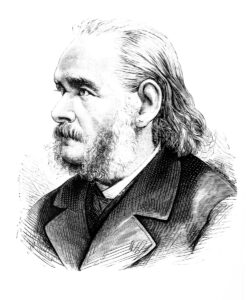Wallace Mendelson describes how an encounter between two scientists resulted in the creation of cell theory.
Matthias Jacob Schleiden (1804-1881), the son of a Hamburg physician, was trained in the law in Heidelberg, and in 1827 returned to his hometown and set up a practice. It was remarkably unsuccessful, and ultimately, he became depressed to the degree that in 1832 he shot himself. He survived, though marked by a scar on his forehead for the rest of his life, and he wisely determined that it might be time to pursue a different profession.
With a lifelong interest in plants and the encouragement of his uncle Johann Horkel who was a botanist, in 1833 Schleiden began to study natural history in Göttingen, and then botany in Berlin. After fruitless applications to several universities, he once again became depressed. After another unsuccessful suicide attempt, his family aided him in finding a position at the University of Jena, where he took his degree in natural history and joined the philosophical faculty.
While in Berlin, Schleiden had been influenced by studies of cell nuclei performed by the Scottish botanist Robert Brown. It was Schleiden’s view that nuclei were essential to embryonic cell development. In 1838, he published a landmark paper asserting that cells were the basic unit of plant life, and that each plant was ultimately produced from a single embryonic cell. As such, he was challenging the notion of spontaneous generation, which held that life somehow appeared from inorganic matter.
Schleiden found himself engaged in a variety of conflicts exacerbated by his imperious manner, and he ran afoul of the church. Overwhelmed and feeling anxious and depressed, he determined that a break from academe was in order and that he might find relief in travel. While doing so, he went to Berlin, where he visited the physician and physiologist Theodor Schwann, whom he had known in his student days.
Schwann was interested in microscopic studies of the developmental relationship of various animal tissues. He was, however, hampered by the limits of the available technology, as the cell walls of animals were less clear than those of plants. It has been said that at a dinner, Schleiden described his work, and Schwann recognised a similarity to what he had seen in nervous system tissue and cartilage. The two began a collaboration, which resulted in an 1839 paper asserting that all plant and animal tissue is comprised of cells, which represent the fundamental building blocks of life.
This notion reached fruition when in 1855 the German pathologist Rudolph Virchow added that all cells are derived from pre-existing cells (‘Omnis cellula e cellula’), thus laying the cornerstone of modern biology.
Serendipity
In looking back at Schleiden’s career, two qualities are of note. One, of course, is his recurring depression, almost costing him his life, which led him both to change his interests to botany, and later to take leave from academe, leading to his fortuitous dinner with Schwann. The second is the casual nature of their encounter, which ultimately resulted in their formulation of cell theory. There were of course other such remarkable encounters.
One is reminded of David Waldie, a physician and chemist with the Liverpool Apothecaries Company. While on vacation in Scotland in 1847, Waldie mentioned to the obstetrician James Young Simpson that chloroform, a treatment for asthma, could cause patients to fall asleep, and that it might have potential as an anesthetic. Similarly, in 1889 there was the serendipitous meeting in a library between Joseph von Mering and Oskar Minkowski, who worked in different institutions inside the University of Strasbourg. Their subsequent studies concluded that the pancreas secretes a substance regulating glucose, later determined to be insulin. Such seemingly casual encounters appear to have germinated into some of the most remarkable contributions to biology and medicine.
Notes and further reading
de Herder, W.W1 and Klöppel, G.: One hundred years after the discovery of insulin and glucagon: the history of tumors and hyperplasias that hypersecrete these hormones, Endocrine Related Cancer 30 (2023), https://erc.bioscientifica.com/downloadpdf/journals/erc/30/9/ERC-23-0046.pdf
Guthrie, D.: David Waldie, a forgotten pioneer of chloroform anesthesia. British Medical Bulletin, Volume 4 (1946), Page 142, https://doi.org/10.1093/oxfordjournals.bmb.a072699
Jahn, L: “Schleiden, Matthias Jacob” in: Neue Deutsche Biographie 23 (2007), S. 52-54 [Online-Version]; URL: https://www.deutsche-biographie.de/pnd118852116.html#ndbcontent
Wallace Mendelson is a US psychiatrist and author, working primarily in the fields of sleep research and psychopharmacology. His most recent book is The Battle Over the Butterflies of the Soul: Camillo Golgi, Santiago Ramón y Cajal and The Birth of Neuroscience (2023).


